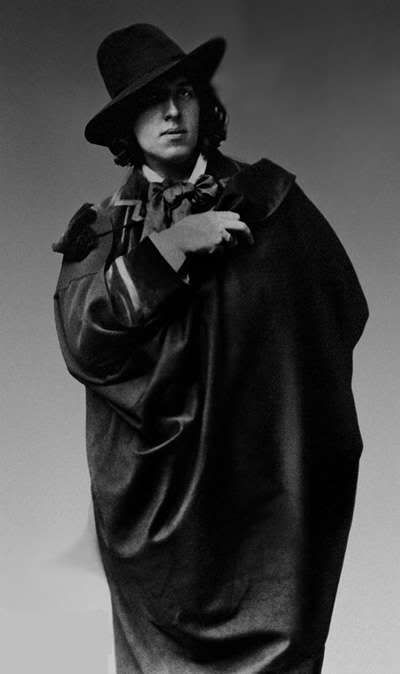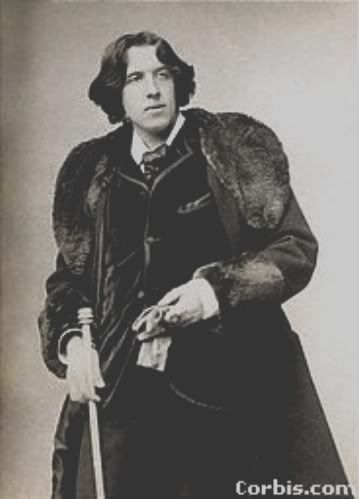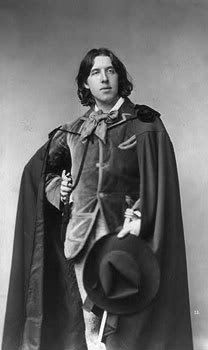Sunday, June 29, 2008
My Final Paper - "Behold, the Magnificent Phonograph"
Anyway, I chose to write something like this for the phonograph, mainly because I felt we didn't spend nearly enough time talking about audio technology, focusing heavily on visual technology (also, I really like this recording). I decided to write as though I were from ye olden days, and I feel I'm more than a bit imitative of Oliver Wendell Holmes, who wrote our first reading.
Anyway, I kind of let loose when creating this, but I actually enjoy the results. I hope you will, as well. And I hope you'll come to the realization, as I did when halfway through, that this must have actually seemed like a frickin' big deal at the time.
(P.S. While I kind of muddle with timelines in this piece, this is an excuse to use my "1890s" tag for a second time. Score!)
***
Like a fine perfume, spoken words, carried by the talented voice of Len Spencer, seeped out the glass panes of the appliance shop to my ears as I was taking a stroll downtown. People casually walking by turned, to perhaps glimpse the man that the sound must have come from. One person even looked at me, as though I were some sort of ventriloquist.
But no; the voice may have been projected, but it was not by my lungs. Instead, it was by a small box, no taller than my chest. This box was the phonograph, a most wondrous invention. Created by Thomas Edison, it may prove even more influential than his electric lantern. With this mechanical device, you can do what one would think is impossible: you can capture sound. What’s more, you can then repeat this captured sound whenever you please. With such an apparatus, we have the opportunity to interact with family, with ourselves, and with the world in an entirely new – and beneficial – way. If you don’t believe me now, or if you’ve never heard of one of these phonographs before, then give me a few moments of your time to explain myself.
I think it prudent to discuss the technical aspects of one of these contraptions. After all, without a proper understanding of the mechanics of today’s technology, it is no better than some possessed trinket. You can just imagine good old Aunt Mabel claiming it to be a work of the devil, can you not? But no, it is not some infernal handicraft, but rather a precisely-tuned instrument. Yes, I said “instrument”. Because, you see, the phonograph works in exactly the same way as any flute or drum.
Let us consider the humble mandolin. When a musician plucks at one of the strings, that piece of catgut would move back and forth. These vibrations disturb the air, much like a well-thrown stone will cause ripples in a pond. However, once these disturbances reach your ear, they then vibrate the inner recesses of your ear, acting as a tiny drum. This, then, causes you to hear the sound in your head. The same holds true with a piano (the vibrations being on the strings inside), the drum (here coming from the skin you beat) and the flute (the very body of the instrument being the tool of the vibrations). And so it is true with the phonograph.
Of course, the phonograph does not use strings. Instead, it uses wax cylinders no larger than a jar of peanut butter. This cylinder is placed on what can best be likened to a spit over a cooking fire. In this way, a crank allows the user to turn the cylinder like a suckling pig. A needle then rests on the cylinder, and attached to this needle is a large cone, similar to a horn or trumpet.
What makes this apparatus so extraordinary is that it can perform dual functions; recording sound and playing it back. When one fastens a small attachment onto the needle, it allows you to speak into the machine. You can input whatever you want, from a friendly greeting to a song to a dramatic reading of Melville. When the large cone catches the vibrations of your voice (themselves created by the movement of the muscles in your throat) it will itself vibrate slightly, enough to move the recording needle up and down. Like a master sculptor of miniscule stature, the needle digs into the wax cylinder, forming small grooves. Within these grooves is magic. Not real magic, mind you; otherwise Aunt Mabel would get her torch ready. No, it is a modern magic, one which captures the sound, exactly how it is, and stores it, as though frozen in time, ready to be played back. And to do this, you simply remove the recording attachment and turn the crank as normal. Now, it simply works in the opposite way; the grooves bump the needle up and down, causing the cone to vibrate in a way which will replicate whatever sound was frozen on the cylinder.
What are amazing about these cylinders are their authenticity and their longevity. A parrot, for example, can “record” a speech, but when you ask it to speak the speech back to you, it will do so in its own voice. The speech may be accurate in its contents, but it is not authentic in voice. A phonograph cylinder, on the other hand, will remember and present you with the speech exactly how was first said. Were you in another room, you’d think speechmaker himself was the one doing the talking. Additionally, while one’s memory of a speech can fade with time, a cylinder will reproduce it with as much accuracy one year from now as it does today. Think of it as an entertainer who will perform unlimited shows after only one payment.
But the use of the phonograph goes far beyond that.
People speak of photography as though it were the second coming of the Lord. I can’t go anywhere without seeing a picture print or stereoscopic image. People flock to these devices, saying that they will revolutionize the way we perceive the world. They will make travel unnecessary, and they will allow family on different sides of the country to know each other as though they were next-door neighbors. All through the “power” of images.
Well, of course people are attracted to this concept. Of all the senses, sight is our primary one. Before all other information is gleaned from a new object or situation, we evaluate it based on what we see. Unfortunately, this also makes sight our most superficial sense. Even though we are told never to judge a book by its cover, that is exactly what we are forced to do with photography: judge something solely by its appearance, rather than its merit.
I hear tell of people putting together moving pictures. They take a number of photographs, all taken in close sequence, and display them as quickly as possible. The effect is to create movement. Currently, the closest we can get to something like this is the zoetrope, but the thought it that we will eventually reach a point where a single pane will be able to display the moving pictures, without any spinning. Personally, I’m not waiting with very much excitement. I’ve seen chronophotographs; I know how systematic human beings work. But what good is it to know that humans move? Animals move. Machines move. And that’s what these moving pictures show us: that we are mechanical as a steam engine.
Sound, on the other hand, is what separates us from the machines, and places us closer to the pantheon of the angels. For it is in sound that the soul comes through, be it through the heavenly voices of a church choir or through an inspirational speech by the president. We may not use sound as our primary sense, but it allows us to pierce deeper into the very core of one’s being. Hence, once the phonograph is ubiquitous, we shall engage in a new culture, one in which we judge others not on the trifling appearances of their clothes and face, but on the very sound of their soul.
But these philosophical ramblings mean nothing if the phonograph ends up serving no palpable purposes. Which indeed, it does. In fact, I dare say that the phonograph shall be the creation which, more than any other man-made machine, shall serve to change the way people around the world interact with each other.
Consider the opera. While an opera can be an uplifting experience, the practice of attending one can be less than pleasant. The modestly-paid enthusiast must attend a show by himself - or at best with his wife - as he cannot afford to purchase tickets for his family and friends. When he reaches the theatre, he must find an uncomfortable chair in a sea of strangers. Later, when his hunger arises, he must get up and leave the performance to purchase refreshment. What a needless hassle! With the phonograph, he can purchase an opera cylinder for half the price of an individual ticket. He can then invite his dear ones into his living room, where he can sit in his favorite recliner. The opera can begin and end whenever he desires. If he takes a break, so does the performance. He may repeat a particular concerto if he desires. He has access to limitless encores. His house, not the big house, becomes the local center of attraction. What a marvelous situation, when a man need not leave his house and still has the choice between “Carmen” and “Madame Butterfly”.
This also presents new opportunities for musical artists. Because one phonograph may record off of another, a musician need only complete his piece once, and it can be replicated as many times as his heart desires. No longer need he perform on every street corner and evening café. He may simply sell cylinders for 50 cents apiece to the general store. In this way, we may need to add a course in our music lessons about proper salesmanship!
And yet, it does not end there. This technology will eventually make written letters obsolete. After all, why should one wish to waste their time writing – or reading – page after page of correspondence, when they may simply place a cylinder in their phonograph and communicate the way it was meant to be done: with voice. Say I wish to send a romantic note to my sweetheart traveling across Europe. I could simply write down a poem, put in the post, and hope she understands its meaning. Or – and I sincerely prefer this – I could actually recite the poem to her, to inflect the important points, to punctuate what needs be punctuated. And in hearing my tender tone, she will feel as though my arms are enfolding her. A slip of paper cannot do that. Should she reciprocate, sending me back a cylinder with her delicate voice, I could close my eyes and imagine her very presence. Indeed, communicating with the phonograph is just like having a conversation with your eyes closed. It is the closest two people on opposite sides of the world will ever come to be.
In fact, once one thinks about it, the phonograph becomes the perfect tool for people to interact with each other. But is it only a means to this end? Certainly not! Should you choose it to be, the phonograph can be a character in and of itself. As Len Spencer’s advertising recording states, “When your wife is worried after the cares of the day, and the children are boisterous, I can rest the one and quiet the other. I never get tired and you will never tire of me, for I will always have something new to offer.” If only every houseguest could offer as much! You’ll notice how it speaks, though, referring to itself in the first person, as though it were a living, breathing person. I have yet to see a camera do that! And it couldn’t, because nobody would believe it. But the phonograph, with its ability to use sound, the foundation of the soul, actually has the ability to pass as a contributing member of the household – one which never needs to be fed.
But was Aunt Mabel correct this whole time? Is the phonograph actually insidious? Shall we lose ourselves in this machine? Not at all; in fact, we shall discover ourselves! We shall go past the superficial details of photography and understand what it is to know the world with our eyes closed.
I think that within a few years, when the phonograph becomes as omnipresent as a bedspread, you will not have to read this piece again. By that time, I will have recorded it on a cylinder and distributed it to all of my readers (who, ironically, wouldn’t be reading anymore). In doing so, all the tones, the inflections, and the passion that I’ve lost in transcribing my thoughts to paper will be regained. Your experience would improve tenfold. This discourse could continue for an infinite number of pages, but I believe you should have a decent understanding of the workings - and the merits - of the phonograph. If not, then I urge you to go to your local appliance store and experience the phonograph for yourself; I think you will be hard-pressed to hold onto that stoicism. Steam power may make travel across the world easy, but it is the phonograph which will actually bring us all together.
Monday, February 19, 2007
Influences, Part I - The Incredible Quotable Oscar Wilde and His 1890s Companions
The first person we shall examine is a certain Mr. Oscar Wilde. You may remember him as the author of such works as The Picture of Dorian Gray, The Importance of Being Earnest, and others.
Despite my enjoyment of his works, they are not the part of him that influences me. In fact, it may not even be the man himself. It is the very idea of him. Look at the following pictures of him:


 To me, his looks alone are the epitome of cool. And I’m not the only one who thinks so. But the part about him that really appeals to me is his intelligence with the English language. The ability to turn a phrase when needed. The ability to be witty on cue. To have quotes aplenty!
To me, his looks alone are the epitome of cool. And I’m not the only one who thinks so. But the part about him that really appeals to me is his intelligence with the English language. The ability to turn a phrase when needed. The ability to be witty on cue. To have quotes aplenty!
I am a fan of quotes (more about this another day). I even have my own last words figured out. But Oscar Wilde is a veritable cornucopia of quotes. Consider the following:
“To love oneself is the beginning of a lifelong romance.”
“I have nothing to declare but my genius.”
“A man's face is his autobiography. A woman's face is her work of fiction.”
“I can resist everything except temptation.”
And finally, the mantra I live by:
“Life is far too important to be taken seriously.”
The list goes on and on. To me, witty quotes are the best kind of comedy there is. Terse, funny, and occasionally insightful.
In addition to a love of quotes, I also am fond of Mr. Wilde’s time period. If I had to choose an olden decade to live in, it would definitely be the 1890s. It doesn’t even matter where, both the
I guess you say for comparison’s sake that like a bee craves pollen, I crave the 1890s.
I must admit, Mr. Wilde isn’t the only tangible factor in my love of the period. There was a Wikipedia article about “S. A. Andrée's Arctic balloon expedition of 1897” that was featured over a year ago. It seemed like such an unusual topic that I had to read it. In the article (which is one of the few long articles I’ve read in its entirety; it’s that interesting). I saw the following picture:
The first thing that popped into my mind: “Wow, those are three of the coolest dudes I’ve ever seen!”
That previous line is neither joke nor hyperbole. I even used this picture of Nils Gustaf Ekholm (who looks suspiciously like Jamie Hyneman from Mythbusters) as my desktop picture for awhile (and writing this has influenced me to use it again).
Unlike Dimas, I have no desire to be a gap-toothed hillbilly in the future. No, my image of the ideal Andrew Schnorr (or at least, one of them) is in a smart three-piece suit, a top hat resting upon my head, and an unnecessary monocle occasionally covering my left eye. A silk cloak would hug my shoulders like a good friend. In my hand is a polished hickory walking stick with a silver, spherical top, perfect for grasping and for bludgeoning. (I always say, using a walking stick is awesome unless you actually need to use it.) A witty socialite in the upper crust of society, I would be invited to luncheons for every occasion under the sun. While gently tapping a spoonful of caviar onto a triangle of bread, I would say to the local manufacturer, “Overworking the machines? Charles, as long as they don’t ask for wages, they can work as long as you please.” The gentle laughter in the background would be my ambrosia.
I’d also like a rival. Every person worth his grain of salt in the 1890s had a rival with whom they could trade verbal barbs with, while their audience laughs at the treat they’re receiving. I imagine my rival as being a gruff scientist-professor type, a few years my elder. Quite serious about his work, but still relatively friendly. I would be the frivolous, happy-go-lucky writer always pestering him. Yes, the writer-scientist rivalry has been a staple of society since time immemorial.
I’d like to give you a couple examples of the kinds of conversations I’d think Professor Attenborough (as I’ve come to call him) and I would have. For your listening pleasure, I’ve included some recordings of these very same conversations so you can listen as your read. While they’re not entirely professionally edited (there’s a few popped P’s in there), I added Vivaldi’s Spring Concerto for effect, it being the official music of high society.
This first scenario takes places when Prof. Attenborough is trying to give a presentation on his newest discovery (on what, I have no idea). I, being the incorrigible scamp that I am, walk in during the middle of it, loudly moving my way through the crowd to find a seat. Banter ensues. Click here to listen. (Imagine there's gentle laughter in the background.) And here’s the transcript:
Attenborough: My good Mr. Schnorr, I’ll thank NOT to intrude upon my presentation!
Me: Well, no need to thank me, then.
Attenborough: And exactly why did you see fit to come here this afternoon?
Me: Well, you see, I was simply trying to understand why you have never listened to any of my counterpoints to argument?
Attenborough: Well, you see, Mr. Schnorr, I have a most peculiar condition of the ear which only allows me to hear the voices of those who have something worthwhile to say.
Me: Heh. If that’s the case, it’s a wonder you can scarce hear anything at all above the tumult which must be my voice ringing in your ears.
Attenborough: Hoh! Your wit will only get you so far, Mr. Schnorr.
Me: If it gets me where I need to go, what more do I ask?
Attenborough: Mmm…please sit down, Mr. Schnorr.
Me: Of course, I would never wish to disturb your…*ahem*…enlightening lecture.
The second scene takes place after the presentation is over and done with. Prof. Attenborough is walking away with his materials, and I am hustling to catch up with him. Listen to the shenanigans here, and read the transcript:
Me: Well, Professor, I must say, I previously underestimated your capacity for experimentation. Why, sitting through that lecture was a true test of human willpower.
Attenborough: Mr. Schnorr, why do you insist on continuing this harassment of me?
Me: Harassment? Ha! Everyone enjoys my company, yourself included. In fact, I’m willing to offer more of it, if you’ll join me in a drink.
Attenborough: A drink? Hoh, Mr. Schnorr, I can see right through your chicanery. You plan to get me inebriated so that I go out and make a fool of myself in public.
Me: Well, I hardly need you inebriated to accomplish that. But no, I was considering a more benign drink, more along the lines of tea.
Attenborough: Tea? Benign? Hoh! There is nothing about that caffeinated concoction. Why, you see, tea is an inflamer of the senses of the senses and an inflamer of the tongue. It makes men speak hastily and in that haste they say nothing but foolish babble.
Me: Calm down, Professor. You make it sound so nefarious.
Attenborough: Anything offered by a nefarious person like yourself, Mr. Schnorr, is in its very nature nefarious.
Me: So I see. And, what if I were to ask you specifically not to join me in my afternoon tea?
Attenborough: Well, then, I would be forced to go, if only to show you that you do not have the power to tell me what to do.
Me: Well, then, I insist you do not come to tea with me this afternoon!
Attenborough: Then I shall be there! And we will both be unhappy!
Both: *Laughter.*
See, despite our constant digs at each other, we remain on friendly terms. What a great relationship!
The influence continues into some of my story ideas. For example, I have an idea for a screenplay which is about bounty hunters in the future. But the thing is, they’re all very dignified and witty. I guess you could say it’s a mix of Blade Runner and The Importance of Being Earnest. In fact, one of the characters actually dresses in a tweed suit, has a silver-capped walking stick, and acts in a manner similar to my time-shifter doppelganger. The character’s name? Oscar, of course!
To be perfectly honest, I probably wouldn’t be happy in the 1890s. No computers, no good transportation, questionable methods of bathing. That is why I specifically avoid saying, “I’d like to live in the 19th Century.” The most accurate way of putting it would be, “I’d like to live in the current century, while daydreaming about the 19th Century.” And wouldn’t you know, that’s what I do!
As for how I write, I wouldn’t say that I exactly “plagiarize” the style of Oscar Wilde and his kin. However, he and his time period have inspired the way I think, which indirectly translates to an influence in my writing. Perhaps there are shades in there I can’t even see.
If nothing else, though: “Life is far too important to be taken seriously.”
Thanks for the advice, Oscar!



